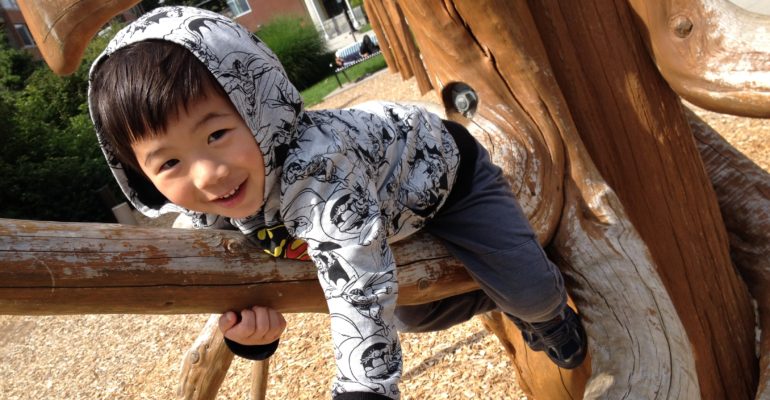Summer is in full swing and what are your kids doing? Or if you do not have kids then what are your nieces and nephews or the neighbourhood kids doing? Are they playing video games or watching TV inside the house or playing outside? If they spend most of their day in front of an electronic screen, then it is time to change their habits now.
I was born in the 70’s and grew up in the 80’s and my generation was still pretty active although the age of video games and computers had already begun. When I was a young child I played on the playground, in my yard, and in the trees behind my yard and I as I got a bit older I played 2 or 3 different organized sports in addition to playing street hockey almost everyday in my early and mid-teens. But I don’t think it is as common with today’s children. Hearing the statistics in the media, most of us are well aware that today’s children are more sedentary and more obese than ever and it appears that it may get worse before it gets better. Granted, the Lower Mainland is better than the rest of the country in this respect due to the agreeable climate and more active lifestyle but it still not immune to the sedentary effect of our technology-driven society.
Being the father of a toddler, I can clearly see the importance and necessity of playing, especially, outdoors. I believe that only playing inside the house is not sufficient for the full development of a child from not only a physical development standpoint but also from cognitive and social aspects. And it is one place where children can be loud and active and act like kids, unlike being inside the house. If your child or children seem to have pent up energy and hyperactivity, maybe they need to go outside and release it. Adults or parents who think children are “little adults” who should know how to self-monitor and behave themselves when made to “keep still for long periods of time” are probably setting themselves up for disappointment and/or disaster. Of course, being outside has potential dangers such as road traffic, criminal activities and possibly dangerous animals but I believe the benefits far outweigh the drawbacks. Parents must simply be intelligent about it
Taking it a step further, just playing outside may not be sufficient. An interesting piece of literature on the topic of “Nature Deficit Disorder”, a hypothesis formed by Richard Louv, indicates that there are benefits to interacting with nature. It also states that an absence or lack of interaction with nature and the outdoors has the potential to lead to a variety of behavioural problems such as attention disorders and depression, along with the growing physical problem of obesity. Interestingly, positive effects of interacting with nature in children have been documented with Attention Deficit (Hyperactivity) Disorder due to the calming effect of nature resulting in a reduction of anxiety levels (Barlow). Whether or not this hypothesis or theory is completely valid is not really the point, what is important is getting children to appreciate nature by playing and discovering the many wonders of it. And I admit, I am not an “outdoor” person but it does appear to have a calming effect on me when I do get a chance to visit the outdoors. So I believe there is some validity to this idea.
They say variety is the spice of life but for children it is beneficial to have exposure to a variety of different outdoor environments such as the beach, the forest, the mountains and areas where snow is present. It is also important to allow them to try a wide variety of foods, especially across different cultures, if possible. And exposing them to many different things will provide the opportunity to a wider spectrum of experiences and perhaps create a foundation to be open-minded as they grow into adults.
A Few Tips for Encouraging Outdoor Play (sparkpeople.com)
Provide simple tools to aid discovery. Kids love tools! Include a bug box, trowel, magnifier, etc.
When you take children to parks and other natural areas, allow them to explore. Let them decide which trails to take. Stay nearby for safety, but don’t interfere or help unless asked.
Encourage plenty of time outside. Consider taking a walk to the library, store or post office instead of driving.
Take a few leaves from different trees while the children are not looking. Give them the leaves and ask them to find which trees they came from.
If a child asks or remarks about a landmark or natural feature you drive past often, find out more about it and go for a visit.
The HUMAN BODY and most of earth’s creatures are meant to be active; moving around constantly changing positions and moving here and there without being in one position for long periods of time as is occurring in today’s society. These sedentary positions are causing an almost epidemic proportion of overweight and obese populations, poor posture, major back problems and a host of health problems linked to a sedentary lifestyle. These problems are presently beginning in childhood when it used to be considered an “adult” problem. Also, the special benefits of being active and in nature could be lost during the window of opportunity at a crucial age of development of children. It is OUR responsibility to get kids active on a regular basis and enjoy the outdoors, when possible.

As a bonus, here is the Canada Introduction to Physical Literacy. This illustrates the importance of developmental movements skills during childhood for sports but more importantly for life! For the full-size PDF click on the link:
introduction-to-physical-literacy
RELATED LINKS
http://www.earlychildhoodnews.com/earlychildhood/article_view.aspx?ArticleID=275
http://www.cbc.ca/news/canada/windsor/lack-of-outdoor-play-said-to-hurt-children-s-development-1.2497526

